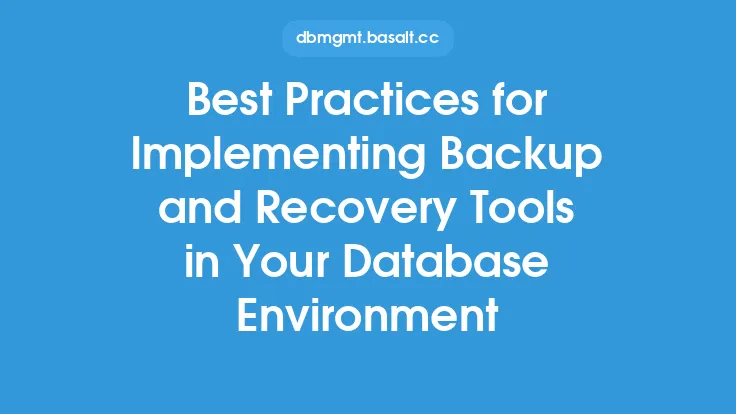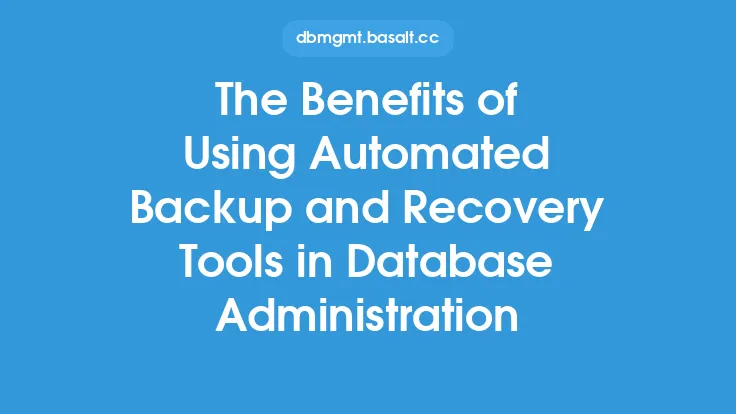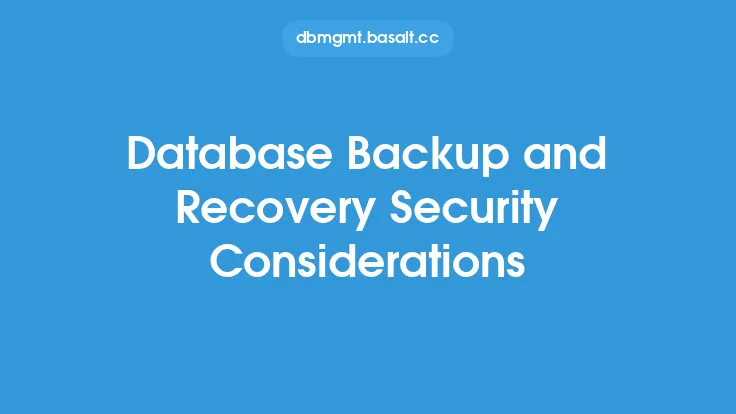Database security and compliance are critical aspects of database management, as they ensure the confidentiality, integrity, and availability of sensitive data. Backup and recovery tools play a vital role in supporting database security and compliance by providing a robust and reliable means of protecting data against various threats, such as data breaches, corruption, and loss. In this article, we will explore how backup and recovery tools support database security and compliance, and discuss the key features and best practices for implementing these tools in a database environment.
Introduction to Database Security and Compliance
Database security and compliance refer to the practices and procedures used to protect sensitive data from unauthorized access, use, disclosure, modification, or destruction. This includes ensuring that data is handled, stored, and transmitted in accordance with relevant laws, regulations, and industry standards, such as the General Data Protection Regulation (GDPR), the Health Insurance Portability and Accountability Act (HIPAA), and the Payment Card Industry Data Security Standard (PCI DSS). Database security and compliance involve a range of measures, including access controls, encryption, auditing, and backup and recovery.
The Role of Backup and Recovery Tools in Database Security
Backup and recovery tools are essential for database security, as they provide a means of protecting data against various threats, such as data breaches, corruption, and loss. These tools enable database administrators to create backups of sensitive data, which can be used to restore the data in the event of a disaster or data loss. Backup and recovery tools also provide a means of verifying the integrity of backups, ensuring that data is not corrupted or tampered with during the backup process. Additionally, these tools can be used to create multiple copies of data, which can be stored in different locations, providing an additional layer of protection against data loss.
Supporting Compliance with Backup and Recovery Tools
Backup and recovery tools also play a critical role in supporting compliance with relevant laws, regulations, and industry standards. For example, many regulations require organizations to retain data for a specified period, such as seven years, and to be able to produce this data in the event of an audit or investigation. Backup and recovery tools enable organizations to meet these requirements by providing a means of creating and storing backups of sensitive data. Additionally, these tools can be used to create audit trails, which provide a record of all changes made to data, including who made the changes, when they were made, and what changes were made. This information can be used to demonstrate compliance with relevant regulations and to investigate any security incidents that may occur.
Key Features of Backup and Recovery Tools for Database Security and Compliance
When selecting backup and recovery tools for database security and compliance, there are several key features to consider. These include:
- Encryption: Backup and recovery tools should provide encryption capabilities to protect data both in transit and at rest.
- Access controls: Backup and recovery tools should provide access controls, such as authentication and authorization, to ensure that only authorized personnel can access and manage backups.
- Auditing: Backup and recovery tools should provide auditing capabilities, such as audit trails, to track all changes made to data and backups.
- Data retention: Backup and recovery tools should provide data retention capabilities, such as the ability to set retention policies, to ensure that data is retained for the required period.
- Data verification: Backup and recovery tools should provide data verification capabilities, such as checksums, to ensure that data is not corrupted or tampered with during the backup process.
Best Practices for Implementing Backup and Recovery Tools
To ensure the effective implementation of backup and recovery tools for database security and compliance, several best practices should be followed. These include:
- Developing a comprehensive backup and recovery strategy that takes into account the organization's data protection and compliance requirements.
- Implementing a regular backup schedule to ensure that data is backed up frequently.
- Storing backups in a secure location, such as an offsite data center or cloud storage service.
- Testing backups regularly to ensure that they can be restored in the event of a disaster or data loss.
- Monitoring backups and backup processes to detect any issues or errors.
- Providing training to personnel on the use and management of backup and recovery tools.
Conclusion
In conclusion, backup and recovery tools play a vital role in supporting database security and compliance by providing a robust and reliable means of protecting data against various threats, such as data breaches, corruption, and loss. By selecting backup and recovery tools with key features, such as encryption, access controls, auditing, data retention, and data verification, and implementing these tools in accordance with best practices, organizations can ensure the confidentiality, integrity, and availability of sensitive data and meet relevant compliance requirements. As data protection and compliance requirements continue to evolve, the importance of backup and recovery tools in supporting database security and compliance will only continue to grow.





